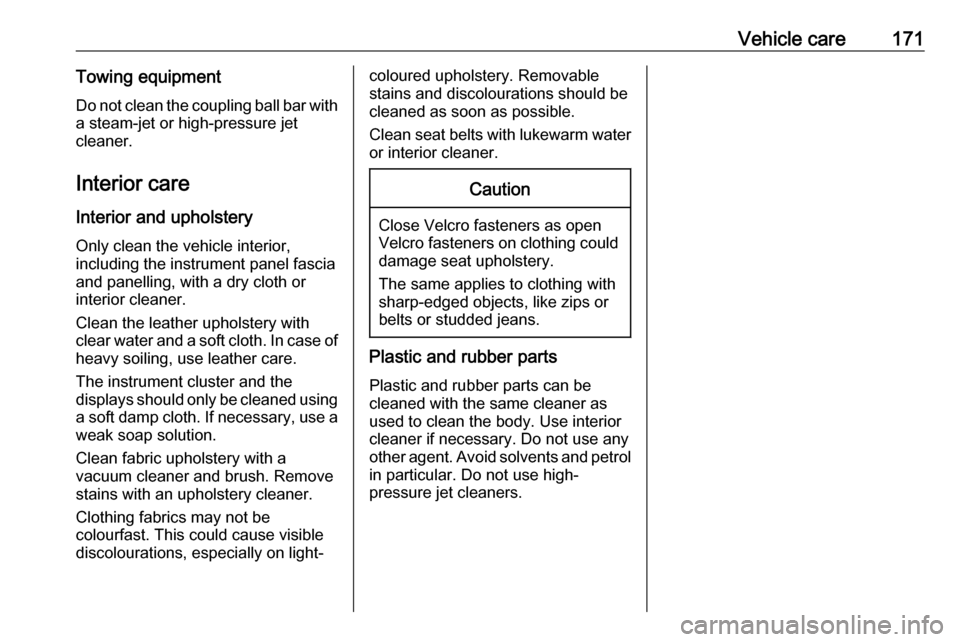towing OPEL COMBO 2017 Manual user
[x] Cancel search | Manufacturer: OPEL, Model Year: 2017, Model line: COMBO, Model: OPEL COMBO 2017Pages: 195, PDF Size: 4.71 MB
Page 113 of 195

Driving and operating111Driving and
operatingDriving hints ............................... 111
Control of the vehicle ...............111
Steering ................................... 111
Starting and operating ...............112
New vehicle running-in ............112
Ignition switch positions ...........112
Starting the engine ..................112
Vehicle shutdown ....................113
Overrun cut-off ........................ 114
Stop-start system ....................114
Parking .................................... 116
Engine exhaust .......................... 117
Diesel particle filter ..................117
Catalytic converter ...................118
Manual transmission ..................118
Manual transmission automa‐ ted .............................................. 119
Transmission display ...............119
Starting the engine ..................119
Selector lever .......................... 120
Manual mode ........................... 121
Electronic driving programmes 122
Fault ........................................ 122Brakes........................................ 123
Antilock brake system .............123
Parking brake .......................... 124
Brake assist ............................. 124
Hill start assist ......................... 125
Ride control systems .................125
Traction Control system ..........125
Electronic Stability Control ......126
Driver assistance systems .........127
Cruise control .......................... 127
Parking assist .......................... 129
Fuel ............................................ 131
Fuel for petrol engines .............131
Fuel for diesel engines ............131
Fuel for natural gas operation . 131
Refuelling ................................ 132
Fuel consumption - CO 2-
Emissions ............................... 134
Trailer hitch ................................ 135
General information .................135
Driving characteristics and towing tips .............................. 135
Trailer towing ........................... 135Driving hints
Control of the vehicle
Never coast with engine not
running (except during Autostop)
Many systems will not function in this
situation (e.g. brake servo unit, power
steering). Driving in this manner is a
danger to yourself and others. All
systems function during an Autostop,
but there will be a controlled reduction in power steering assist and vehicle
speed is reduced.
Stop-start system 3 114.
Pedals
To ensure the pedal travel is
uninhibited, there must be no mats in the area of the pedals.
Steering If power steering assist is lost
because the engine stops or due to a system malfunction, the vehicle can
be steered but may require increased
effort.
Page 120 of 195

118Driving and operatingControl indicator % illuminates when
diesel particle filter is full. Start cleaning process as soon as possible to avoid damage to the engine.
Cleaning process
To activate cleaning process,
continue driving, keep engine speed
above 2000 rpm. Shift down if
necessary. Diesel particle filter
cleaning is then started.Caution
If the cleaning process is
interrupted, there is a risk of
provoking severe engine damage.
Cleaning takes place quickest at high engine speeds and loads.
Control indicator % extinguishes as
soon as the self-cleaning operation is
complete.
Catalytic converter
The catalytic converter reduces the
amount of harmful substances in the
exhaust gases.
Caution
Fuel grades other than those listed on pages 3 131, 3 178 could
damage the catalytic converter or
electronic components.
Unburnt petrol will overheat and
damage the catalytic converter.
Therefore avoid excessive use of the starter, running the fuel tank
dry and starting the engine by
pushing or towing.
In the event of misfiring, uneven
engine running, a reduction in engine performance or other unusual
problems, have the cause of the fault
rectified by a workshop as soon as
possible. In an emergency, driving
can be continued for a short period,
keeping vehicle speed and engine
speed low.
Manual transmission
To engage reverse, with the vehicle
stationary, wait three seconds after
depressing the clutch pedal, pull up
the collar on the selector lever and
engage the gear.
If the gear does not engage, set the
lever to neutral, release the clutch
pedal and depress again; then repeat
gear selection.
Do not slip the clutch unnecessarily.
When operating, depress the clutch
pedal completely. Do not use the
pedal as a foot rest.
Page 132 of 195

130Driving and operating● The bumper is damaged. Takethe vehicle to a workshop to
repair the system.
● Other conditions, such as vibrations from a jackhammer,
are affecting system
performance.
In the event the system still does not
work properly, seek the assistance of
a workshop.
A warning chime is also sounded
briefly if a fault is present when
reverse gear is engaged 3 94.
Note
The volume of the warning chime
can also be adjusted via the Driver
Information Centre 3 89.
Important hints for using the
parking assist systems9 Warning
Under certain circumstances,
various reflective surfaces on
objects or clothing as well as
external noise sources may cause the system to fail to detect
obstacles.
Special attention has to be paid to
low obstacles which can damage
the lower part of the bumper. If
such obstacles leave the detection area of the sensors during
approach of the vehicle, a
continuous warning tone will
sound.Caution
Performance of the sensor can be reduced when sensors are
covered, e.g. by ice or snow.
Performance of the parking assist
systems can be reduced due to
heavy loading.
Special conditions apply if there
are taller vehicles involved (e.g.
off-road vehicles, mini vans,
vans). Object identification in the upper part of these vehicles
cannot be guaranteed.
Objects with a very small reflection
cross section, like objects of
narrow size or soft materials, may
not be detected by the system.
Parking assist will not avoid a
collision with objects which are out
of the detection range of the
sensors.
Note
The parking assist system
automatically detects factory-fitted
towing equipment. It is deactivated
when the connector is plugged in.
The sensor may detect a non-
existent object (echo disturbance)
caused by external acoustic or
mechanical disturbances.
Page 137 of 195

Driving and operating135Trailer hitch
General information
Only use towing equipment that has
been approved for your vehicle.
Vehicles with natural gas engine may
require special towing equipment.
Entrust retrofitting of towing
equipment to a workshop. It may be
necessary to make changes that
affect the cooling system, heat
shields or other equipment.
Fitting of towing equipment could
cover the opening of the towing eye.
If this is the case use the coupling ball bar for towing. Always keep the
coupling ball bar in the vehicle.
Driving characteristics and towing tips
Before attaching a trailer, lubricate
the coupling ball. However, do not do so if a stabiliser, which acts on the
coupling ball, is being used to reduce
snaking movements.For trailers with low driving stability
and caravan trailers with a permitted
gross vehicle weight of more than
1300 kg the use of a stabiliser is
strongly recommended when driving
above 80 km/h.
If the trailer starts snaking, drive more slowly, do not attempt to correct the
steering and brake sharply if
necessary.
When driving downhill, drive in the
same gear as if driving uphill and
drive at a similar speed.
Adjust tyre pressure to the value
specified for full load 3 185.
Trailer towing
Trailer loads The permissible trailer loads are
vehicle and engine-dependent
maximum values which must not be
exceeded. The actual trailer load is the difference between the actual
gross weight of the trailer and the
actual coupling socket load with the
trailer coupled.The permissible trailer loads are
specified in the vehicle documents. In general, they are valid for gradients
up to max. 12%.
The permitted trailer load applies up
to the specified incline and up to an
altitude of 1000 metres above sea
level. Since engine power decreases
as altitude increases due to the air
becoming thinner, therefore reducing
climbing ability, the permissible gross
train weight also decreases by 10%
for every 1000 metres of additional
altitude. The gross train weight does
not have to be reduced when driving
on roads with slight inclines (less than 8%, e.g. motorways).
The permissible gross train weight
must not be exceeded. This weight is
specified on the identification plate
3 175.
Vertical coupling load
The vertical coupling load is the load
exerted by the trailer on the coupling
ball. It can be varied by changing the
weight distribution when loading the
trailer.
Page 138 of 195

136Driving and operatingThe maximum permissible vertical
coupling load (60 kg) is specified on
the towing equipment identification
plate and in the vehicle documents.
Always aim for the maximum load,
especially in the case of heavy
trailers. The vertical coupling load
should never fall below 25 kg.
Rear axle load The permissible axle loads (see
identification plate or vehicle
documents) must not be exceeded.
Page 139 of 195

Vehicle care137Vehicle careGeneral Information...................137
Accessories and vehicle modifications .......................... 137
Vehicle storage ........................138
End-of-life vehicle recovery .....138
Vehicle checks ........................... 139
Performing work ......................139
Bonnet ..................................... 139
Engine oil ................................. 140
Engine coolant ......................... 141
Power steering fluid .................141
Washer fluid ............................ 142
Brakes ..................................... 142
Brake fluid ............................... 142
Vehicle battery ......................... 143
Wiper blade replacement ........144
Bulb replacement .......................145
Halogen headlights ..................145
Fog lights ................................. 147
Tail lights ................................. 147
Side turn signal lights ..............148
Centre high-mounted brake light ......................................... 148
Number plate light ...................148Interior lights ............................ 149
Instrument panel illumination ...150
Electrical system ........................151
Fuses ....................................... 151
Engine compartment fuse box . 152
Instrument panel fuse box .......153
Vehicle tools .............................. 154
Tools ........................................ 154
Wheels and tyres .......................155
Winter tyres ............................. 155
Tyre designations ....................155
Tyre pressure .......................... 156
Tyre pressure monitoring
system .................................... 157
Tread depth ............................. 158
Changing tyre and wheel size . 159 Wheel covers ........................... 159
Tyre chains .............................. 159
Tyre repair kit .......................... 159
Wheel changing .......................162
Spare wheel ............................ 163
Jump starting ............................. 166
Towing ....................................... 167
Towing the vehicle ...................167
Towing another vehicle ...........168
Appearance care .......................169
Exterior care ............................ 169
Interior care ............................. 171General Information
Accessories and vehiclemodifications
We recommend the use of genuine
parts and accessories and factory
approved parts specific for your
vehicle type. We cannot assess or guarantee reliability of other products
- even if they have a regulatory or
otherwise granted approval.
Any modification, conversion or other
change made to standard vehicle
specifications (including, without
limitation, software modifications,
modifications of the electronic control units) may invalidate the warrantyoffered by Opel. Furthermore, such
changes may impact fuel
consumption, CO 2 emissions and
other emissions of the vehicle and
cause the vehicle to no longer
conform to the type approval,
impacting the validity of your vehicle
registration.
Page 169 of 195

Vehicle care1673. Connect the black lead to thenegative terminal of the booster
battery.
4. Connect the other end of the black
lead to a vehicle grounding point,
such as the engine block or an
engine mounting bolt. Connect as far away from the discharged
vehicle battery as possible,
however at least 60 cm.
Route the leads so that they cannot
catch on rotating parts in the engine
compartment.
To start the engine: 1. Start the engine of the vehicle providing the jump.
2. After five minutes, start the other engine. Start attempts should be
made for no longer than
15 seconds at an interval of
one minute.
3. Allow both engines to idle for approx. three minutes with the
leads connected.4. Switch on electrical consumers (e.g. headlights, heated rear
window) of the vehicle receiving
the jump start.
5. Reverse above sequence exactly when removing leads.Towing
Towing the vehicle
Release the cap by carefully lifting
with a screwdriver. To prevent
damage, it is recommended to place
a cloth between the screwdriver and
the frame.
The towing eye is stowed with the vehicle tools 3 154.
Screw in the towing eye as far as it will
go until it stops in a horizontal
position.
Attach a tow rope – or better still a tow
rod – to the towing eye.
Page 170 of 195

168Vehicle careCaution
The towing eye must only be usedfor towing and not for recovering
the vehicle.
Switch on ignition to release steering
wheel lock and to permit operation of
brake lights, horn and windscreen
wiper.
Transmission in neutral.
Note
If neutral cannot be selected on
vehicles with manual transmission
automated (MTA), the vehicle must
only be towed with the drive wheels
raised off the ground.
Caution
Drive slowly. Do not drive jerkily.
Excessive tractive force can
damage the vehicle.
When the engine is not running,
considerably more force is needed to
brake and steer.
To prevent the entry of exhaust gases from the towing vehicle, switch on the
air recirculation 3 106 and close the
windows.
Seek the assistance of a workshop. After towing, unscrew the towing eye
and replace the cap.
Towing another vehicle
Insert a screwdriver in the slot at the
side of the cap. Release the cap by
carefully levering the screwdriver. To
prevent damage it is recommended to place a cloth between the screwdriver
and the frame.
The towing eye is stowed with the vehicle tools 3 154.
Screw in the towing eye as far as it will
go until it stops in a horizontal
position.
Attach a tow rope – or even better a tow bar – to the towing eye.
The towing eye must only be used for
towing and not for recovering a
vehicle.Caution
Drive slowly. Do not drive jerkily.
Excessive tractive force can
damage the vehicle.
After towing, unscrew the towing eye.
Insert cap.
Page 173 of 195

Vehicle care171Towing equipmentDo not clean the coupling ball bar with
a steam-jet or high-pressure jet
cleaner.
Interior care
Interior and upholstery Only clean the vehicle interior,
including the instrument panel fascia
and panelling, with a dry cloth or
interior cleaner.
Clean the leather upholstery with
clear water and a soft cloth. In case of
heavy soiling, use leather care.
The instrument cluster and the
displays should only be cleaned using
a soft damp cloth. If necessary, use a weak soap solution.
Clean fabric upholstery with a
vacuum cleaner and brush. Remove
stains with an upholstery cleaner.
Clothing fabrics may not be
colourfast. This could cause visible
discolourations, especially on light-coloured upholstery. Removable
stains and discolourations should be
cleaned as soon as possible.
Clean seat belts with lukewarm water or interior cleaner.Caution
Close Velcro fasteners as open
Velcro fasteners on clothing could
damage seat upholstery.
The same applies to clothing with
sharp-edged objects, like zips or
belts or studded jeans.
Plastic and rubber parts
Plastic and rubber parts can be
cleaned with the same cleaner as
used to clean the body. Use interior cleaner if necessary. Do not use any
other agent. Avoid solvents and petrol in particular. Do not use high-
pressure jet cleaners.
Page 191 of 195

189Cigarette lighter ........................... 74
Climate control ............................. 16
Climate control systems .............105
Clock....................................... 71, 89
CNG............................................ 184
Collision damage repair ..............186
Control indicators.......................... 78
Control of the vehicle .................111
Controls ........................................ 69
Convex shape .............................. 30
Coolant and antifreeze ...............173
Cruise control ...................... 89, 127
Cupholders .................................. 60
D Danger, Warnings and Cautions ...4
Date .............................................. 89
Daytime running lights ............89, 99
Declaration of conformity ............186
Diesel particle filter ...............85, 117
Distance to next service ...............89
Door open .................................... 89
Doors ...................................... 26, 27
Drain fuel filter ............................. 88
Driver assistance systems ..........127
Driver Information Centre .............89
Driving characteristics and towing tips .............................. 135
Driving hints ................................ 111E
Eco mode (E).............................. 122
Electric adjustment ......................30
Electrical system......................... 151
Electronic climate control system 107
Electronic driving programmes ..122
Electronic Stability Control ..84, 126
Electronic Stability Control (ESC). 84
End-of-life vehicle recovery .......138
Engine compartment fuse box ...152
Engine coolant ........................... 141
Engine coolant temperature ........85
Engine coolant temperature gauge ....................................... 77
Engine data ............................... 178
Engine exhaust .......................... 117
Engine identification ...................176
Engine oil ...........140, 173, 177, 184
Engine oil pressure ......................86
ESC (Electronic Stability Control) 126
Event data recorders ..................186
Exit lighting ................................ 104
Extendable load compartment cover ................................... 62, 66
Exterior care .............................. 169
Exterior light ................................. 88
Exterior lighting ......................13, 98
Exterior mirrors ............................. 30F
Fault ........................................... 122
Fixed air vents ........................... 109
Fog light ....................................... 89
Fog lights ................................... 147
Folding front passenger seat ........38
Folding mirrors ............................. 30
Folding seats .......................... 40, 42
Front airbag system .....................51
Front fog lights ........................... 100
Front passenger seat Folding ...................................... 38
Table position ............................ 38
Front seats.................................... 36
Front storage ................................ 60
Front turn signal light ..................145
Fuel............................................. 131
Fuel consumption .........................89
Fuel consumption - CO 2-
Emissions ............................... 134
Fuel cut-off system .........80, 95, 113
Fuel for diesel engines ..............131
Fuel for natural gas operation ...131
Fuel for petrol engines ...............131
Fuel gauge ................................... 76
Fuel selector ................................ 76
Fuel system messages .........95, 113
Fuel tank ..................................... 184
Fuses ......................................... 151